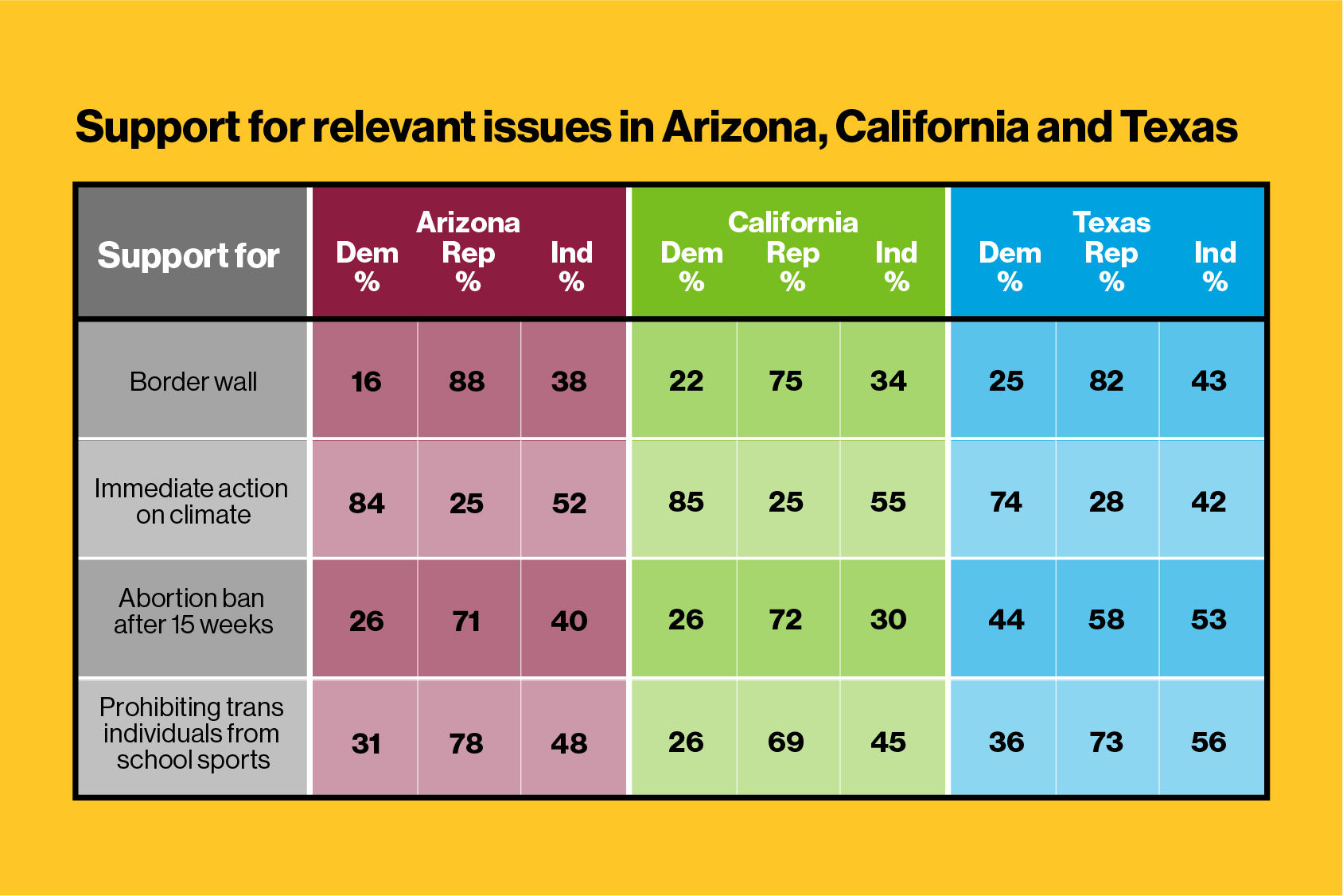
2023 The Power of Partisanship
A joint polling project among researchers at Arizona State University, Stanford University and the University of Houston.
Do Democrats, Republicans and Independents in Arizona, California and Texas look similar across state lines in terms of strength of party attachment, ideological fervor and policy positions on current and perplexing issues? A new study looks at political affiliation across the three states and how the data can inform campaign messaging and strategies.
Executive summary
The foundational strategy for Republican and Democratic presidential candidates to reach the 270 Electoral College votes needed to be elected president consists of carrying historically loyal states with a large number of electors while also winning a key number of “battleground states.”
The largest prize for Democratic candidates is California. California has 55 Electoral College votes, largest in the nation, and has voted for the Democratic candidate continuously since 1992. In 2020, Biden defeated Trump in California 63.48% to 34.32% with over 17 million votes cast.
The biggest prize for the Republican candidate is Texas, with 38 Electoral College votes, and Texas has voted for the Republican candidate continuously since 1980. In 2020, Trump defeated Biden in Texas 52.06% to 46.48% with over 11 million votes cast. These are the largest states in the Electoral College.
One of the most intense battleground states is suddenly Arizona. It has 11 Electoral College votes and in 2020 Biden defeated Trump 49.36% to 49.06% with over 3.3 million votes cast. The last time a Democratic candidate carried Arizona was 1996. ...
About the survey
The survey upon which this report is based was conducted between May 31 and June 6, 2023 among a representative sample of Arizona, California and Texas residents age 18 and older. In all, 3,163 respondents were surveyed across the three states: Arizona (1,051), California (1,045) and Texas (1,067), with the margin of error for each state +/- 3.0%.
Other published analyses in the three-state survey series and related publications are listed below:
- 2023 Abortion: A joint polling project among researchers at Arizona State University, Stanford University and the University of Houston.
- 2023 Transgender Legislation and Policies: A joint polling project among researchers at Arizona State University, Stanford University and the University of Houston.
Research team
David Brady, Senior Fellow at the Hoover Institution and Stanford Institute for Economic Policy Research; Professor of Political Economics at the Graduate School of Business and Political Science, Emeritus, Stanford University
Bruce Cain, Charles Louis Ducommun Professor in the School of Humanities and Sciences; Senior Fellow at the Woods Institute for the Environment; Senior Fellow at the Stanford Institute for Economic Policy Research; Professor at the Stanford Doerr School of Sustainability, Stanford University
Kim Fridkin, Foundation Professor, School of Politics and Global Studies, Arizona State University
Preeti Hehmeyer, Managing Director, California Policy Research Initiative at the Stanford Institute for Economic Policy Research
Mark P. Jones, James A. Baker III Institute for Public Policy's Fellow in Political Science, Rice University; Senior Research Fellow, Hobby School of Public Affairs, University of Houston
Patrick Kenney, Dean and Foundation Professor, The College of Liberal Arts and Sciences; Executive Vice Provost, Arizona State University
Richard Murray, Senior Research Fellow, Hobby School of Public Affairs, University of Houston
Doug Rivers, Professor of Political Science and Senior Fellow at the Hoover Institution, Stanford University
